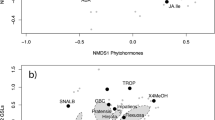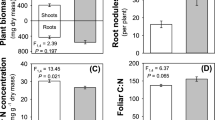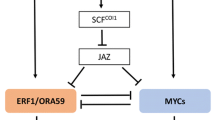Abstract
We experimentally demonstrate that elevated CO2 can modify herbivory-induced plant chemical responses in terms of both total and individual glucosinolate concentrations. Overall, herbivory by larvae of diamondback moths (Plutella xylostella) resulted in no change in glucosinolate levels of the annual plant Arabidopsis thaliana under ambient CO2 conditions. However, herbivory induced a significant 28–62% increase in glucosinolate contents at elevated CO2. These inducible chemical responses were both genotype-specific and dependent on the individual glucosinolate considered. Elevated CO2 can also affect structural defenses such as trichomes and insect-glucosinolate interactions. Insect performance was significantly influenced by specific glucosinolates, although only under CO2 enrichment. This study can have implications for the evolution of inducible defenses and coevolutionary adaptations between plants and their associated herbivores in future changing environments.



Similar content being viewed by others
References
Agrawal AA (1999) Induced-responses to herbivory in wild radish: effects on several herbivores and plant fitness. Ecology 80:1713–1723
Agrawal AA, Karban R (1999) Why induced defenses may be favored over constitutive defenses strategies in plants. In: Tollrian R, Harvell CD (eds) The ecology of inducible defenses. Princeton University Press, NJ, pp 45–61
Anderson VL, McLean RA (1974) Design of experiments. Marcel Dekker, New York
Antonovics J (1992) Toward community genetics. In: Fritz RS, Simms EL (eds) Plant resistance to herbivores and pathogens. University of Chicago Press, Illinois, pp 426–449
Bano FA (1993) Glucosinolates in Arabidopsis. Dissertation, University of East Anglia, Norwich
Bazin A, Goverde M, Erhardt A (2002) Influence of atmospheric carbon dioxide enrichment on induced response and growth compensation after herbivore damage in Lotus corniculatus. Ecol Entomol 27:271–278
Berenbaum MR (1995) The chemistry of defense: theory and practice. Proc Natl Acad Sci USA 92:2–8
Berenbaum MR, Zangerl AR (1992) Quantification of chemical coevolution. In: Fritz RS, Simms EL (eds) Plant resistance to herbivores and pathogens. The University of Chicago Press, Chicago, pp 69–87
Bergelson J, Stahl E, Dudek S, Kreitman M (1998) Genetic variation within and among populations of Arabidopsis thaliana. Genetics 148:1311–1323
Bezemer TM, Jones TH (1998) Plant–insect herbivore interactions in elevated atmospheric CO2: quantitative analyses and guild effects. Oikos 82:212–222
Bidart-Bouzat MG (2004) Herbivory modifies the lifetime fitness response of Arabidopsis thaliana to elevated CO2. Ecology 85:297–303
Bird SM, Gray JE (2003) Signals from the cuticle affect epidermal cell differentiation. New Phytologist 157:9–23
Brunner E, Domhof S, Langer F (2002) Nonparametric analysis of longitudinal data in factorial experiments. Wiley, New York
Bryant JP, Chapin FS, Klein DR (1983) Carbon/nutrient balance of boreal plants in relation to vertebrate herbivory. Oikos 40:357–368
Ciska E, Martyniak-Przybyszewska B, Kozlowska H (2000) Content of glucosinolates in cruciferous vegetables grown at the same site for two years under different climatic conditions. J Agric Food Chem 48:2862–2867
Fajer ED, Bowers MD, Bazzaz FA (1989) The effects of enriched carbon dioxide atmospheres on plant–insect herbivore interactions. Science 243:1198–1200
Fraenkel GS (1959) The raison d’etre of secondary plant substances. Science 129:1466–1470
Gershenzon J (1984) Changes in the levels of plant secondary metabolites under water and nutrient stress. Recent Adv Phytochem 18:273–320
Hamilton JG, Zangerl AR, DeLucia EH, Berenbaum MR (2001) The carbon-nutrient balance hypothesis: its rise and fall. Ecol Lett 4:86–95
Holton MK, Lindroth RL, Nordheim EV (2003) Foliar quality influences tree-herbivore-parasitoid interactions: effects of elevated CO2, O3, and plant genotype. Oecologia 137:233–244
Hughes JB, Daily GC, Ehrlich PR (1997) Population diversity: its extent and extintion. Science 278:689–691
Joutei AB, Van Impe JRG, Lebrun P (2000) Effect of elevated CO2 on the demography of a leaf-sucking mite feeding on bean. Oecologia 123:75–81
Karowe DN, Seimens DH, Mitchell-Olds T (1997) Species-specific response of glucosinolate content to elevated atmospheric CO2. J Chem Ecol 23:2569–2582
Kennedy GG, Barbour JD (1992) Resistance variation on natural and managed systems. In: Fritz RS, Simms EL (eds) Plant resistance to herbivores and pathogens. The University of Chicago Press, Chicago, pp 13–41
Kessler A, Baldwin IT (2004) Herbivore-induced plant vaccination. Part I. The orchestration of plant defenses in nature and their fitness consequences in the wild tobacco, Nicotiana attenuata. Plant J 38:639–649
Kliebenstein DJ (2001) Genetic control of natural variation in Arabidopsis glucosinolate accumulation. Plant Physiol 126:811–825
Kliebenstein D, Pedersen D, Barker B, Mitchell-Olds T (2002) Comparative analysis of quantitative trait loci controlling glucosinolates, myrosinase and insect resistance in Arabidopsis thaliana. Genetics 161:325–332
Kopper BJ, Lindroth RL, Nordheim EV (2001) CO2 and O3 effects on paper birch (Betulaceae: Betula papyrifera) phytochemistry and whitemarked tussock moth (Lymantriidae: Orgyia leucostigma) performance. Environ Entomol 30:1119–1126
Lindroth RL, Kinney KK (1998) Consequences of enriched atmospheric CO2 and defoliation for foliar chemistry and gypsy moth performance. J Chem Ecol 24:1677–1695
Lindroth RL, Roth S, Nordheim EV (2001) Genotypic variation in response of quaking aspen (Populus tremuloides) to atmospheric CO2 enrichment. Oecologia 126:371–379
Magrath R, Herron C, Giamoustaris A, Mithen R (1993) The inheritance of aliphatic glucosinolates in Brassica napus. Plant Breeding 111:55–72
Mauricio R, Rausher MD (1997) Experimental manipulation of putative selective agents provides evidence for the role of natural enemies in the evolution of plant defense. Evolution 51:1435–1444
McCloud ES, Berenbaum MR (1999) Effects of enhanced UV-B radiation on a weedy forb (Plantago lanceolata) and its interactions with a generalist and specialist herbivore. Entomol Exp Appl 93:233–247
Mithen R (2001) Glucosinolates—biochemistry, genetics and biological activity. Plant Growth Regul 34:91–103
Mithen R, Campos H (1996) Genetic variation of alphatic glucosinolates in Arabidopsis thaliana and prospects for map based gene cloning. Entomol Exp Appl 80:202–205
Mithen R, Raybould AF, Giamoustaris A (1995) Divergent selection for secondary metabolites between wild populations of Brassica oleracea and its implications for plant–herbivore interactions. Heredity 75:472–484
Nayar JK, Thorsteinson AJ (1963) Further investigations into the chemical basis os insect–host plant relationships in an oligophagous insect, Plutella maculipennis (Curtis) (Lepidoptera: Plutellidae). Can J Zool 41:923–929
Neuhauser C et al (2003) Community genetics: expanding the synthesis of ecology and genetics. Ecology 84:545–558
Penuelas J, Estiarte M (1998) Can elevated CO2 affect secondary metabolism and ecosystem function? TREE 13:20–24
Potvin C, Roff DA (1993) Distrubution-free and robust statistical methods: viable alternatives to parametric statistics. Ecology 74:1617–1628
Quarrie SA, Jones HG (1977) Effect of abscisic acid and water stress on development and morphology of wheat. J Exp Bot 28:192–203
Ratcliffe D (1961) Adaptation to habitat in a group of annual plants. J Ecol 49:187–203
Roth S, Lindroth RL, Volin JC, Kruger EL (1998) Enriched atmospheric CO2 and defoliation: effects on tree chemistry and insect performance. Global Change Biol 4:419–430
Siemens DH, Mitchell-Olds T (1998) Evolution of pest-induced defenses in Brassica plants: tests of theory. Ecology 79:632–646
Stahl E (1888) Pflanzen und Schnecken. Biologische studie uber die Schutzmittel der Pflanzen gegen Schneckenfrass. Jenaische Zeitschrift fur Medizin und Naturwissenschaft 22:557–684 (Translation to English by G. Fraenkel 1959)
Stowe KA (1998) Realized defense of artificially selected lines of Brassica rapa: effects of quantitative genetic variation in foliar glucosinolate concentration. Environ Entomol 27:1166–1174
Strauss SY, Rudgers JA, Lau JA, Irwin RE (2002) Direct and ecological costs of resistance to herbivory. TREE 17:278–284
Talekar NS, Shelton AM (1993) Biology, ecology, and management of the diamondback moth. Annu Rev Entomol 38:275–301
Tollrian R, Harvell CD (1999) The evolution of inducible defenses: current ideas. In: Tollrian R, Harvell CD (eds) The ecology and evolution of inducible defenses. Princeton University Press, NJ, pp 306–321
Traw MB, Lindroth RL, Bazzaz FA (1996) Decline in gypsy moth (Lymantria dispar) performance in an elevated CO2 atmosphere depends upon host plant species. Oecologia 108:113–120
Vallejo F, Tomas-Barberan FA, Gonzalez A, Benavente-Garcia O, Garcia-Viguera C (2003) Total and individual glucosinolate contents in inflorescences of eight broccoli cultivars grown under various climatic and fertilisation conditions. J Sci Food Agric 83:307–313
Whitham TG, Young WP, Martinsen GD, Gehring CA, Schweitzer JA, Shuster SM, Wimp GM, Fischer DG, Bailey JK, Lindroth RL, Woolbright S, Kuske CR (2003) Community and ecosystem genetics: a consequence of the extended phenotype. Ecology 84:559–573
Zangerl AR, Berenbaum MR (1990) Furanocoumarin induction in wild parsnip: genetics and populational variation. Ecology 7:1933–1940
Acknowledgements
We are very grateful to Juan L. Bouzat and Ken Paige for helpful comments on previous versions of this manuscript, Daniel Warnock and Evan deLucia for providing materials for this experiment, and the Arabidopsis Biological Resource Center for supplying seeds for this experiment. This work was funded by a Sigma Xi Grant-in-Aid of Research to M.G.B.B.
Author information
Authors and Affiliations
Corresponding author
Additional information
Communicated by Richard Lindroth
Rights and permissions
About this article
Cite this article
Bidart-Bouzat, M.G., Mithen, R. & Berenbaum, M.R. Elevated CO2 influences herbivory-induced defense responses of Arabidopsis thaliana . Oecologia 145, 415–424 (2005). https://doi.org/10.1007/s00442-005-0158-5
Received:
Accepted:
Published:
Issue Date:
DOI: https://doi.org/10.1007/s00442-005-0158-5




